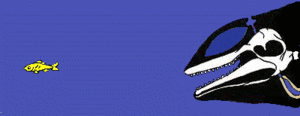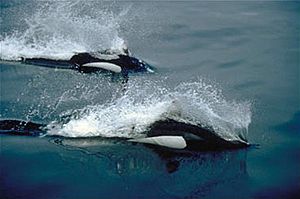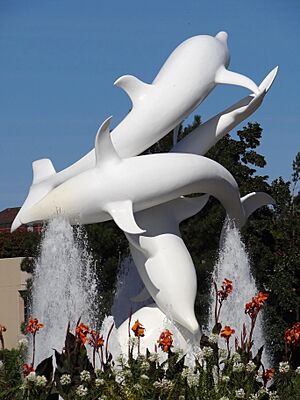Porpoise facts for kids
Quick facts for kids Porpoise |
|
|---|---|
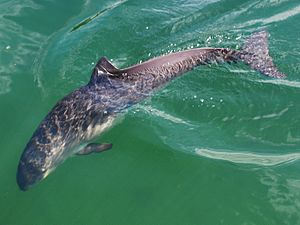 |
|
| The harbor porpoise (Phocoena phocoena) | |
| Scientific classification |
|
| Kingdom: | Animalia |
| Phylum: | Chordata |
| Class: | Mammalia |
| Order: | Artiodactyla |
| Infraorder: | Cetacea |
| Superfamily: | Delphinoidea |
| Family: | Phocoenidae Gray, 1825 |
| Type genus | |
| Phocoena Cuvier, 1816
|
|
| Genera | |
|
See text |
|
Porpoises are small sea mammals that look a lot like dolphins. They belong to the family Phocoenidae. Even though they look like dolphins, they are actually more closely related to narwhals and beluga whales. There are eight different species of porpoise living today. They are some of the smallest members of the toothed whale group.
You can tell a porpoise from a dolphin by looking at its teeth and face. Porpoises have flat, spade-shaped teeth, while dolphins have cone-shaped teeth. Porpoises also have shorter, rounded snouts without a long "beak."
Porpoises live in oceans and rivers all over the world. They are smart, social animals that use sound to explore their underwater world.
Contents
What Makes a Porpoise a Porpoise?
Size and Shape
Porpoises come in different sizes. The smallest is the vaquita, which is about 1.4 metres (4 feet 7 inches) long and weighs 54 kilograms (119 pounds). The largest is the Dall's porpoise, which can be 2.3 m (7 ft 7 in) long and weigh 220 kg (490 lb). In many species, the females are slightly larger than the males.
They have smooth, streamlined bodies shaped like a torpedo, which helps them swim fast. Their two front limbs are shaped like flippers to help them steer. Like all whales and dolphins, they have a layer of fat called blubber under their skin. Blubber works like a winter coat to keep them warm in cold water.
How They Are Different from Dolphins
- Teeth: Porpoises have flat, spade-shaped teeth. Dolphins have sharp, cone-shaped teeth.
- Face: Most dolphins have a long snout called a beak. Porpoises have a shorter, more rounded head.
- Dorsal Fin: The fin on their back is usually small and triangular, while a dolphin's is often curved.
Where Do Porpoises Come From?
Porpoises, along with all whales and dolphins, have an amazing history. Their ancestors were land animals with hooves that lived about 50 million years ago! Over millions of years, these animals adapted to life in the water.
Fossil evidence shows that porpoises and dolphins branched off from their last common ancestor about 15 million years ago. The oldest porpoise fossils were found in the North Pacific Ocean.
How Porpoises Live
Anatomy and Body Parts
Porpoises have a round head and a body built for swimming. They can't turn their necks very much because some of their neck bones are fused together. This helps keep them stable when swimming at high speeds.
To breathe, they have a single blowhole on top of their head. When they surface, they blow out old air in a steamy puff and then breathe in fresh air.
Their stomach has three parts to help them digest their food. Baby porpoises are born with a thin layer of blubber, but they quickly get thicker by drinking their mother's milk, which is very high in fat.
Swimming and Movement
Porpoises are powerful swimmers. They move their strong tail fin up and down to push themselves through the water. Their flippers are used for steering, much like the rudder on a boat.
Some porpoises can swim very fast. Sometimes they will leap out of the water, a behavior called "porpoising," which might help them travel faster or just be for fun!
Senses and Communication
Echolocation: Seeing with Sound
Porpoises have a special way of navigating and finding food called echolocation. They send out high-frequency clicks from a fatty organ in their forehead called the melon. These clicks bounce off objects like fish, and the returning echoes tell the porpoise the object's size, shape, and location. It's like seeing with sound!
Hearing and Sight
Porpoises have excellent hearing that is adapted for listening underwater. They don't have external ear flaps like we do. Instead, they hear sound through their lower jaw, which sends vibrations to their inner ear.
Their eyes are small but work well. They are located on the sides of their head, giving them a wide view. Special adaptations in their eyes help them see clearly both above and below the water.
Smell and Taste
Scientists believe porpoises have no sense of smell. They also don't seem to have a strong sense of taste, but they can still have favorite types of fish to eat.
How Porpoises Sleep
Porpoises have a unique way of sleeping. They can't fall completely asleep like humans because they need to consciously go to the surface to breathe. To solve this, they rest one half of their brain at a time. While one half sleeps, the other half stays awake to control their breathing and watch for danger. This is called unihemispheric sleep.
Life Cycle and Behavior
Reproduction and Calves
A female porpoise gives birth to a single baby, called a calf, after being pregnant for about a year. The calf is born underwater, tail-first, so it doesn't drown.
The mother feeds her calf special milk that is very thick and fatty, almost like toothpaste. The mother squirts the milk into the calf's mouth. This rich milk helps the baby grow a thick layer of blubber quickly. Calves stay with their mothers for one to two years to learn and stay safe.
What Porpoises Eat
Porpoises are carnivores and eat a variety of sea creatures. Their main diet includes fish, squid, and sometimes shrimp or krill.
- The harbour porpoise mostly eats fish found near the seafloor.
- The Dall's porpoise loves to eat squid and small fish like sardines.
- The finless porpoise in Japan has been seen herding small fish called sand lances toward the shore to catch them more easily.
Porpoises and People
Studying Porpoises
For a long time, people, including the ancient Greek philosopher Aristotle, thought porpoises were a type of fish. But as scientists studied them more closely, they realized they were mammals, just like us. Because harbour porpoises live close to shore in Europe, they were one of the first species that scientists could study in detail.
Porpoises in Aquariums
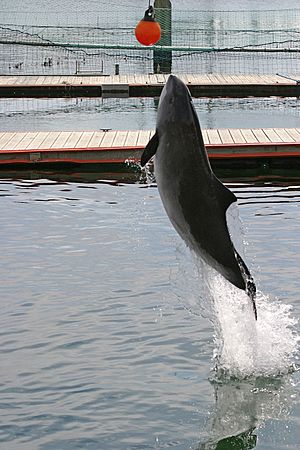
Some porpoises live in aquariums and marine centers. This allows scientists to study them up close and teach the public about them. In the past, it was difficult to keep porpoises healthy in human care, but experts have learned much more about their needs.
Today, some centers have successfully bred porpoises. For example, the world's first harbour porpoise born and raised in an aquarium was in Denmark in 2007. This research helps with conservation efforts for porpoises in the wild.
Threats to Porpoises
Porpoises face several dangers, many of which are caused by human activities.
Getting Caught in Fishing Nets
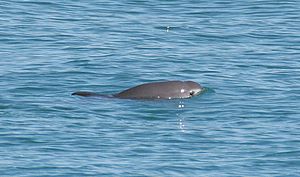
One of the biggest threats to porpoises is getting accidentally caught in fishing nets, which is called bycatch. They can get tangled and are unable to come to the surface to breathe.
This is a very serious problem for the vaquita, a tiny porpoise that lives only in the Gulf of California in Mexico. The vaquita is critically endangered, with very few left in the wild, mainly because of fishing nets set for other animals.
Hunting
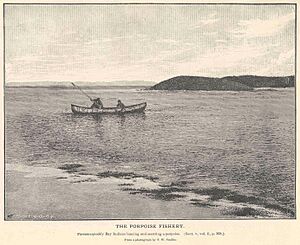
In the past, porpoises were hunted in many parts of the world for their meat and blubber. While this is less common today, some hunting still occurs. For example, thousands of Dall's porpoises are hunted each year in Japan.
Ocean Pollution and Noise
Pollution is another major threat. Chemicals and plastics in the water can make porpoises sick.
Loud underwater noise from large ships, military sonar, and construction can also be harmful. This noise can confuse porpoises, interfere with their echolocation, and cause them stress, sometimes leading them to swim into dangerous areas.
Conservation: How We Can Help
Many people and organizations are working to protect porpoises. Several species are protected under international agreements.
- Protected Areas: Governments have created marine protected areas where activities like certain types of fishing are not allowed. This gives porpoises a safe place to live and raise their young.
- Safer Fishing Gear: Laws like the Marine Mammal Protection Act encourage the use of fishing gear that is safer for marine mammals and helps reduce bycatch.
- Saving the Vaquita: In Mexico, there is a major effort to save the vaquita. This includes banning the dangerous fishing nets in their habitat and patrolling the waters to stop illegal fishing.
- Helping the Yangtze Finless Porpoise: In China, scientists have moved some of these porpoises to safer, protected parts of the Yangtze River to help their population grow.
By studying these amazing animals and reducing the threats they face, we can help ensure that porpoises continue to swim in our world's oceans and rivers for years to come.
See also
 In Spanish: Marsopas para niños
In Spanish: Marsopas para niños
- List of individual cetaceans



